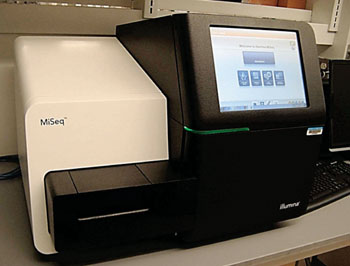Novel Urine Test Predicts High-Risk Cervical Cancer
By LabMedica International staff writers
Posted on 30 Nov 2016
A urine test has been developed for the likely emergence of cervical cancer that is highly accurate compared to other tests based on genetic markers derived directly from cervical tissue.Posted on 30 Nov 2016
The new urine test is different because it analyzes not only multiple sources of human cellular DNA altered by precancerous changes, but also DNA from human papilloma virus (HPV) that is sexually transmitted and causes virtually all cases of the disease.

Image: The MiSeq desktop sequencer for genome sequencing (Photo courtesy of Illumina).
An international team of scientists working with those at Johns Hopkins School of Medicine (Baltimore, MD, USA) tested a biomarker panel in cervical epithelium DNA obtained from 211 women evaluated in a cervical cancer clinic in Chile from 2006 to 2008. The results were verified in a prospective cohort of 107 women evaluated in a high-risk clinic in Puerto Rico from 2013 to 2015. The investigators had identified three genes associated with cervical cancer or abnormal-looking cells known to become cancerous: FK506 Binding Protein 6 (FKBP6), Integrator Complex Subunit 1(INTS1) and Zinc Finger Protein 516 (ZNF516). As abnormalities progress, these genes were more likely to have a chemical methyl group attached to their DNA in certain spots.
Samples were polymerase chain reaction amplified using sample-specific index primers for multiplexed sequencing on a MiSeq System (Illumina, San Diego, CA, USA). Using methylation as a value to diagnose malignancy, the three genes together showed a 90% sensitivity, meaning that their presence was able to predict a true positive cancer sample this percentage of the time and the test had an 88.9% specificity. To further improve the accuracy of the test, the investigators added a new gene marker to the test. This time, rather than using a human gene, they used one from the virus, HPV16-L1, which also becomes methylated in human cells as cancer develops.
The team repeated the test with the four-gene combination on a new population of women from the University of Puerto Rico. The 115 women ranged in age from 21 to 49; 41 participants had healthy cervical tissue, and 74 had one of three types of precancerous cells. Using all four genes, the test now had a sensitivity of 90.9% and a specificity of 60.9%. They then tested 40 samples of paired cervical tissue, blood and urine from a subset of the patients from Puerto Rico. Using the DNA from blood, they found the test had an 85.7% sensitivity and a 60.9% specificity and using urine, they found a 75% sensitivity and an 83.3% specificity. The time to process cervical samples, blood or urine and get a test result took four days and the team plan to continue modifying the test to improve the urine sensitivity to that of the cervical tissue samples.
Rafael Guerrero-Preston, DrPH, MPH, an assistant professor and lead investigator said, “Our urine test would serve as a molecular triage, at times supplementing Pap test information. In developing countries that don’t have the money, medical infrastructure or cultural approval for Pap test, our test could be used instead.” The study was published on November 8, 2016, in the journal Cancer Prevention Research.
Related Links:
Johns Hopkins School of Medicine
Illumina














